
The golden trevally, also known as the golden kingfish, banded trevally or king trevally, is a species of large marine fish classified in the jack and horse mackerel family Carangidae, and the only member of the monospecific genus Gnathanodon. The golden trevally is widely distributed throughout the tropical and subtropical waters of the Indian and Pacific Oceans, ranging from South Africa in the west to Central America in the east, extending to Japan in the north and Australia in the south. The species predominantly occupies inshore waters where it inhabits both reef and sandy substrates. The golden trevally is easily distinguished from its relatives by its fleshy, rubbery lips and unique colouration, which ranges from bright yellow with black bars as a juvenile to a golden-silvery colour as an adult. It is known to grow to 120 centimetres (47 in) in length and 15 kilograms (33 lb) in weight. The golden trevally schools as a juvenile, often closely following larger objects including sharks and jellyfish. The species uses its protractile jaws to suck out prey from the sand or reef, and consumes a variety of fish, crustaceans and molluscs. Spawning aggregations gather at night at different times of the year throughout its range. The golden trevally is a considerable constituent of several Middle Eastern fisheries and being of minor importance to many others, with a worldwide annual catch of 1,187 metric tons to 3,475 metric tons recorded between 2000 and 2010. The golden trevally is a popular gamefish, taken by bait, lure, fly and also spear throughout its range. Several Asian countries currently farm the fish in caged aquaculture. Due to their brilliant colouration, juveniles are popular in marine aquaria.

The shrimp scad, is a species of widespread tropical marine fish of the jack family, Carangidae. The shrimp scad is widely distributed in the tropical and subtropical western Indian Ocean and areas of the eastern Pacific Ocean, ranging from South Africa in the west to Hawaii in the east, including Japan and Australia to the north and south. The species is commonly found on inshore reefs and sandy substrates. It has the common body profile of a scad, and may be difficult to differentiate from others in the genus Alepes. It is one of the larger scads, growing to 40 cm, but often is encountered at much smaller sizes. The shrimp scad often forms large schools, and is carnivorous, consuming a variety of crustaceans and small fish. It is of moderate importance to fisheries throughout its range.

The Malabar trevally, also known as the Malabar jack, Malabar kingfish or nakedshield kingfish, is a species of large inshore marine fish of the jack family, Carangidae. It is distributed throughout the Indian and west Pacific Oceans from South Africa in the west to Japan and Australia in the east, inhabiting reefs and sandy bays on the continental shelf. The Malabar trevally is similar to many of the other species in the genus Carangoides, with the number of gill rakers and the grey-brown colour of the tongue being the diagnostic features. The Malabar trevally is a predator, taking a variety of small fish, cephalopods and crustaceans. The species is of minor economic importance throughout its range, caught by a variety of net and handline methods.
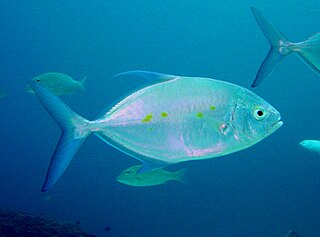
Carangoides is a genus of tropical to subtropical marine fishes in the jack family, Carangidae. They are small- to large-sized, deep-bodied fish characterised by a certain gill raker and jaw morphology, often appearing very similar to jacks in the genus Caranx. They inhabit the subtropical and tropical regions of the Indian, Pacific, and Atlantic Oceans, often occupying coastal areas, including reefs, bays, and estuaries, rarely venturing far offshore. They are all predatory fishes, taking a variety of smaller fishes, crustaceans and cephalopods as prey. The genus was first erected in 1851 by Pieter Bleeker for an unknown taxon and currently contains 20 species. Many make up significant proportions of various fisheries, although a number of ciguatera cases have been attributed to them.

The longfin trevally, also known as the longfin kingfish, longfin cavalla or armed trevally, is a species of inshore marine fish in the jack family, Carangidae. The species is common in tropical to subtropical waters of the Indo-Pacific, ranging from South Africa in the west to Japan in the east, typically inhabiting inshore reefs and bays. The species is easily distinguished by its elongate dorsal and anal fin lobes and filamentous dorsal rays, as well as its scaleless breast. Longfin trevally are pelagic predators, taking a variety of small fish, cephalopods and crustaceans, and reach sexual maturity at around 21 cm. The species has a maximum known length of 57 cm and weight of 3.5 kg. The longfin trevally has a very complex taxonomic history which is closely intertwined with another currently valid species, Carangoides ciliarius, which may yet prove to be synonymous. Longfin trevally are of minor importance to fisheries throughout their range and are considered good table fish, and are occasionally taken by anglers.
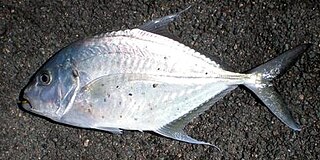
The longnose trevally, also known as the tea-leaf trevally, club-nosed trevally, grunting trevally or dusky trevally, is a species of inshore marine fish in the jack family, Carangidae. The species is distributed throughout the tropical and subtropical waters of the Indian and west Pacific Oceans from South Africa to New Zealand and Japan, inhabiting coastal waters, especially reefs, to a depth of 90 m. The longnose trevally is distinguished from similar species by a combination of a scaleless breast and the number of gill rakers and fin rays. It is a moderately large fish, growing to a maximum known length of 72 cm and 4.35 kg. The longnose trevally is a predatory fish, consuming small fish, crustaceans and molluscs. The species is of minor commercial importance throughout its range, and is considered to be a good table fish.

The coastal trevally, also known as the onion trevally, Japanese trevally or bluefin kingfish, is a species of inshore marine fish in the jack family Carangidae. The species is distributed throughout the tropical and subtropical waters of the Indian and west Pacific Oceans, from South Africa in the west to Japan and New Caledonia in the east, reaching as far south as Australia. The species is found on deep coastal reefs, both in schools and as solitary individuals, where they prey on small midwater organisms including crustaceans, small fish and cephalopods. The species is taken as bycatch in a number of fisheries throughout its range by a number of fishing methods and is of little commercial value, but is considered to be a good table fish. A mistype in the original volume in which Eduard Rüppell named the species led to the combination Carangoides caeruleopinnatus, which has incorrectly spread through the literature.

The shadow trevally, also known as the shadow kingfish, twothread trevally or Aldabra trevally, is a species of inshore marine fish in the jack family Carangidae. The species is patchily distributed throughout the tropical and subtropical waters of the Indian and west Pacific Oceans, from South Africa in the west to Japan and Samoa in the east, reaching as far south as Indonesia and New Caledonia. It is most easily distinguished from similar species by as series of dark rectangular blotches under the second dorsal fin, giving a 'shadowed' appearance, from which its common name is derived. The shadow trevally is a reasonably large fish, growing to 85 cm in length and at least 2.6 kg in weight. It inhabits shallow coastal waters, including reefs, bays, and estuaries, where it takes small fish and benthic crustaceans as prey. Nothing is known of the species' ecology and reproductive biology. It is of little importance to fisheries, and is occasionally taken by bottom trawls and other artisanal fishing gear.

Caranx is a genus of tropical to subtropical marine fishes in the jack family Carangidae, commonly known as jacks, trevallies and kingfishes. They are moderate- to large-sized, deep-bodied fishes which are distinguished from other carangid genera by specific gill raker, fin ray and dentition characteristics. The genus is represented in the Pacific, Indian and Atlantic Oceans, inhabiting both inshore and offshore regions, ranging from estuaries and bays to deep reefs and offshore islands. All species are powerful predators, taking a variety of fish, crustaceans and cephalopods, while they in turn are prey to larger pelagic fishes and sharks. A number of fish in the genus have a reputation as powerful gamefish and are highly sought by anglers. They often make up high amounts of the catch in various fisheries, but are generally considered poor to fair table fishes.
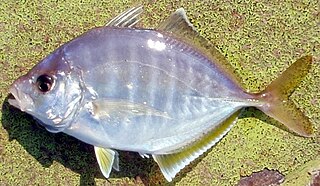
The whitefin trevally, also known as the horse trevally, is a species of deep water offshore fish in the jack family Carangidae. The species inhabits the tropical to temperate waters of the Indo-Pacific and central Pacific, ranging from South Africa in the west to Hawaii in the east. The whitefin trevally is a moderate-sized fish, growing to 37 cm, and is distinguished by a number of morphological traits, including fin size, gill raker count, and colour. It inhabits the continental shelf and slope at depths to 200 m over sand and mud substrates, where it preys on fish, crustaceans, and cephalopods. Studies in Japan indicate a length at sexual maturity of 17.4 cm on average, with spawning occurring between May and October, with each individual spawning multiple times. Whitefin trevallies are of high importance to fisheries in Japan, where they are taken by trawlers, although the catch numbers have halved since the 1980s. It is of minor importance elsewhere throughout its range, but is considered a good table fish.

The blue trevally, also known as the banded trevally, barred trevally, Ferdau's trevally or Forskaal's jackfish, is a common, widespread species of pelagic marine fish classified in the jack family, Carangidae. The blue trevally is distributed throughout the tropical and subtropical waters of the Indo-Pacific and central Pacific regions, ranging from South Africa in the west to Hawaii in the east. It is a moderately large fish, growing to a recorded maximum length of 70 cm, with the number of rays in the second dorsal fin and the colouring serving as diagnostic features of the species. The species inhabits waters to depths of 60 m, generally inhabiting reefs, beaches, lagoons, and areas with sandy substrates. It is a predatory fish, taking other fish, prawns, crabs, and molluscs, and very little is known of the species' reproductive biology. The blue trevally is of varying importance to fisheries throughout its range, with some regions having high catches of the fish. It is considered to be a gamefish, and is sought after for its excellent eating qualities.

The yellowspotted trevally, also known as the yellowspotted kingfish, goldspotted trevally, tarrum, or yellowspot, is a widespread species of large inshore marine fish in the jack family Carangidae. The yellowspotted trevally inhabits the tropical and subtropical waters of the western Indo-Pacific region, from South Africa in the west to Japan and Australia in the east. The species is known to grow to a maximum length of at least 1.2 m, and is distinguished by gill raker and fin morphology, as well as the distinctive golden spots which give the fish its name. The yellowspotted trevally generally prefers inshore rocky and coral reefs, but is occasionally found over deep offshore sand banks to a depth of 100 m. It is a predatory fish, taking fish, cephalopods, and crustaceans, and shows diet partitioning with other trevallies in studies conducted in Australian waters. Reproduction is poorly studied, although observational evidence suggests spawning occurs in aggregations, probably during summer in South Africa. It is generally of minor importance to commercial fisheries throughout its range, but is considered an excellent sportfish by anglers and spearfishermen, and a good table fish.

The bumpnose trevally, also known as the bumpnose kingfish or onion kingfish, is a species of relatively small inshore marine fish classified in the jack family Carangidae. The bumpnose trevally is fairly common in the tropical and subtropical waters of the Indo-west Pacific region, ranging from South Africa in the west to Japan and Samoa in the east. It is a small species by carangid standards, reaching a maximum known length of 32 cm, and can be distinguished from the similarly shaped Carangoides armatus by a distinct 'bump' on the snout, which gives the fish its common name. The species inhabits coastal waters, often living along bays and beaches, where it takes shrimp, small crabs, and juvenile fish as prey. The bumpnose trevally is of minor importance to fisheries throughout its range, taken by hook and line, trawls, and seine nets. It is also of minor importance to anglers, taken by baits from beaches and piers, and is considered a modest table fish.

The duskyshoulder trevally or epaulet trevally, is a species of small inshore marine fish in the jack family, Carangidae. It is distributed through the eastern Indian and western Pacific Oceans, ranging from eastern India to northern Australia and Taiwan. It is relatively small by carangid standards, reaching only 27 cm maximum length, and can be distinguished by the large, black blotches on its shoulders. The duskyshoulder trevally is an inshore fish living in waters less than 50 m deep, over sandy substrates in bays and on the continental shelf. It is a predatory fish, taking demersal fishes, crustaceans, and cephalopods, with nothing known of its reproductive habits. It is of little value to fisheries, often taken as bycatch in prawn trawling operations.
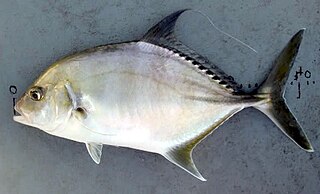
The coachwhip trevally, also known as the oblong trevally or oblique-banded trevally, is a species of inshore marine fish classified in the jack family Carangidae. The coachwhip trevally is distributed through the Indo-west Pacific region, ranging from South Africa in the west to Fiji and Japan in the east. It is a moderately large fish, growing to a known maximum length of 46 cm and can be distinguished from similar species by an array of detailed morphological features including dentition, fin ray counts and scale patterns. The coachwhip trevally inhabits coastal waters throughout its range, known to prefer estuarine waters in a number of localities. Nothing is known of its diet or reproductive biology, and is of little importance to fisheries, occasionally taken as bycatch in trawl and hook and line fisheries.

The barcheek trevally, also known as the barcheek kingfish, shortridge trevally or oblique-banded trevally, is a species of moderately large marine fish of the jack family Carangidae. The barcheek trevally is distributed throughout the tropical waters of the Indo-west Pacific region, ranging from South Africa in the west to Japan, Australia and a number of small central Pacific islands in the east. The species inhabits inshore and offshore waters, found along the slopes of lagoons and out to deeper reefs on the continental shelf, where it preys on small fish and benthic crustaceans. It is a moderately large fish, growing to a maximum recorded length of 50 cm, and can be distinguished from similar species by its somewhat protruding lower jaw and the dark banding on its operculum. It is of minor importance to fisheries throughout its range, taken by trawling, hook and line methods and various inshore fish netting methods.
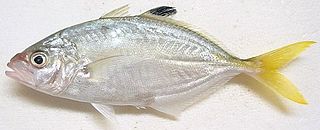
The brownback trevally, also known as the brown-backed trevally, is a species of small inshore marine fish classified in the jack family, Carangidae. The brownback trevally is distributed in two populations through the tropical waters of the Indo-west Pacific region, ranging from the Persian Gulf east to India, South East Asia and the Indonesian islands. The species is distinguished from similar species by its completely scaled breast and black-tipped second dorsal fin, and is known to reach a maximum length of 25 cm. The brownback trevally inhabits inshore waters including bays and estuaries, where it preys on demersal crustaceans and small fish. Other aspects of its biology are poorly known, and it is of minor importance to fisheries, occasionally caught by hook and line or trawls. William Smith-Vaniz has recently suggested the two distinct populations may actually represent two distinct species.

The imposter trevally, also known as the imposter jack or white-tongued trevally, is a species of small coastal marine fish in the jack family Carangidae. The imposter trevally is distributed through the tropical waters of Indian and west Pacific oceans, from the Gulf of Oman in the west to Japan and Australia in the east. The species is quite similar to the Malabar trevally, but can be distinguished by its gill raker count, and is identifiable from other species by having a white to pale grey tongue. It is a relatively small species, growing to a maximum recorded length of 30 cm. The imposter trevally inhabits coastal waters of the continental shelf in depths of up to 140 m, often associating with closely related carangid species. It preys on a range of small fish, crustaceans and cephalopods, but little is known of its reproductive biology. The imposter trevally is of minor importance to fisheries throughout its range, taken by hook and line, bottom trawls and several types of artisanal gear.

The blacktip trevally, also known as the blacktip kingfish or yellowtail kingfish, is a species of large marine fish classified in the jack family Carangidae. The blacktip trevally is distributed throughout the tropical to subtropical Indian and West Pacific Oceans, ranging from South Africa in the west to Fiji, Japan and northern Australia in the east. It inhabits coastal waters throughout its range, preferring moderately deep clear waters over rocky and coral reefs. The blacktip trevally is easily distinguished by its yellow fins and a dark upper caudal fin lobe which gives the species its common name, as well as a host of other anatomical features. The species is known to reach a maximum size of 1 m. It is a benthopelagic predator, commonly forming small shoals where it takes a variety of fishes, cephalopods and crustaceans as prey. Little is known of reproduction in the species, and spawning is assumed to take place in more tropical regions of its range, with juveniles known to inhabit bays and large estuaries. Blacktip trevally are often caught using hook and line and various nets in commercial fisheries although don't make up a large part of the market. They are also popular with anglers due to their fighting ability and decent table qualities.

The brassy trevally, Caranx papuensis is a species of large marine fish classified in the jack family, Carangidae.























